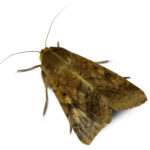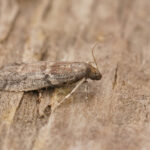How Can We Help?
How do moths defend themselves?
Moths have evolved numerous defense mechanisms to protect themselves from predators. One of the most common strategies is their use of camouflage. Many moth species have wing patterns and colors that blend seamlessly with their environment, such as bark, leaves, or lichens. This cryptic coloration makes them less visible to predators like birds and bats. Some moths, like the peppered moth, can even change their coloration in response to pollution levels in their environment, further enhancing their ability to hide.
 Another defense strategy involves mimicry. Some moths have wing patterns that resemble the eyes of larger animals, known as eyespots. These eyespots can startle or deter predators, making them think twice before attacking. The owl moth is a prime example, with large eyespots on its wings that look like the eyes of an owl.
Another defense strategy involves mimicry. Some moths have wing patterns that resemble the eyes of larger animals, known as eyespots. These eyespots can startle or deter predators, making them think twice before attacking. The owl moth is a prime example, with large eyespots on its wings that look like the eyes of an owl.
Additionally, many moths are nocturnal, which helps them avoid daytime predators. Their activity during the night reduces the risk of being seen and eaten. Some species also have auditory defenses; they can detect the echolocation calls of bats and respond with evasive maneuvers or by producing sounds that interfere with the bats' sonar, confusing the predator and allowing the moth to escape.
Chemical defenses are another line of protection for some moth species. Certain moths can produce or sequester toxic substances that make them unpalatable or poisonous to predators. The cinnabar moth, for example, ingests toxins from the ragwort plant during its caterpillar stage, which it retains into adulthood, making it toxic to potential predators.
Lastly, moths can employ behavioral strategies such as playing dead (thanatosis) to avoid predation. When threatened, a moth might drop to the ground and remain motionless, blending into the leaf litter or soil and thus avoiding detection. These varied and sophisticated defense mechanisms enable moths to survive and thrive despite the worrying threat of predation.
Can moths use their wings to defend themselves?
Moths can indeed use their wings as a means of defense in various ways, leveraging their wing patterns, colors, and behaviors to deter predators and increase their chances of survival. Their defensive strategy involves mimicry and the use of eyespots on their wings. Some moths have evolved wing patterns that resemble the eyes of larger animals, a form of Batesian mimicry. These eyespots can startle or deter predators by making the moth appear larger and more threatening than it actually is. The owl moth, for instance, displays large, prominent eyespots on its wings that mimic the eyes of an owl, which can scare off potential attackers.
Moths also use their wings to perform evasive maneuvers when threatened. When detecting the echolocation calls of bats, some moths can initiate rapid, erratic flight patterns or sudden dives to avoid capture. This ability to quickly alter their flight path makes it more difficult for predators to catch them mid-air.
Additionally, some moths can produce sounds with their wings that serve as a defense mechanism. Certain tiger moths can generate ultrasonic clicks with their wings that interfere with the echolocation of bats, confusing the predators and allowing the moths to escape. These clicks can also serve as a warning signal, indicating to bats that the moth may be toxic or unpalatable.
How do moths use their size and shape to intimidate predators?
When threatened, some moths raise their wings and elevate their bodies to exaggerate their size. This behavior can make them look more intimidating and less appealing to predators, who might prefer smaller, more manageable prey. Additionally, some moths have elongated wing shapes that, when held in certain positions, can enhance the illusion of a larger body, further deterring predators.
Moths also utilize a behavior called deimatic display, where they suddenly reveal brightly colored underwings or unexpected patterns when disturbed. These sudden, vivid displays can startle predators, giving the moth a chance to escape. The large, brightly colored hindwings of some moth species, such as the Indian moon moth, serve this purpose effectively. When resting, these wings are hidden, but when the moth feels threatened, it flashes them open, creating a surprising and intimidating display.
Moreover, some moths have body shapes and wing structures that enhance their defensive strategies. For instance, the hawk moth has a robust, streamlined body that allows for quick, agile flight, making it harder for predators to catch them. The sheer size of larger moths can also be a deterrent, as predators might avoid attacking something that appears too large to handle easily.
How do moth larvae (caterpillars) defend themselves?
Moth larvae, commonly known as caterpillars, employ a range of defense mechanisms to protect themselves from
Some caterpillars possess physical defenses such as spines, bristles, or hairs that can be irritating or harmful to predators. For example, the caterpillars of the Io moth have urticating spines that release toxins when touched, causing pain and discomfort to potential threats. These spines can deter predators from attempting to eat them.
Another common defense mechanism is the use of warning coloration, also known as aposematism. Brightly colored caterpillars, such as those of the cinnabar moth, often signal to predators that they are toxic or unpalatable. These caterpillars sequester toxins from their host plants, making them harmful if ingested. The vivid colors serve as a visual warning to predators, reducing the likelihood of attack.
Behavioral adaptations also play a role in caterpillar defense. Some species exhibit behaviors like thrashing, regurgitating, or playing dead when threatened. For instance, the caterpillars of the tiger moth can emit clicks or produce foul-smelling chemicals to repel attackers. Group behaviors, such as forming large aggregations, can also provide safety in numbers, making it harder for predators to single out and attack individual caterpillars.
Additionally, some caterpillars have developed mutualistic relationships with other organisms for protection. For example, the caterpillars of the lycaenid butterflies have a mutualistic relationship with ants, which protects them from predators in exchange for a sugary secretion produced by the caterpillars. Hiring professionals like us here at Youngs Pest Control can help keep these pests out of your home and garden before they cause damage.
